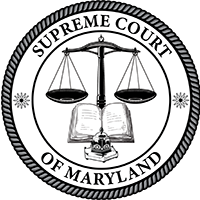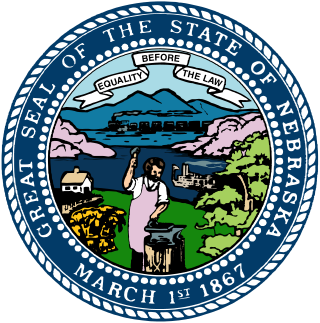Related Research Articles
In the United States, a state supreme court is the highest court in the state judiciary of a U.S. state. On matters of state law, the judgment of a state supreme court is considered final and binding in both state and federal courts.
The government of the U.S. state of Missouri is organized into the state government and local government, including county government, and city and municipal government.

The Tennessee Supreme Court is the highest court in the state of Tennessee. The Supreme Court's three buildings are seated in Nashville, Knoxville, and Jackson, Tennessee. The Court is composed of five members: a chief justice, and four justices. As of September 1, 2023, the chief justice is Holly M. Kirby.

The Supreme Court of Maryland is the highest court of the U.S. state of Maryland. The court, which is composed of one chief justice and six associate justices, meets in the Robert C. Murphy Courts of Appeal Building in the state capital, Annapolis. The term of the Court begins the second Monday of September. The Court is unique among American courts in that the justices wear red robes.

The Alaska Supreme Court is the state supreme court for the U.S. state of Alaska. Its decisions are binding on all other Alaska state courts, and the only court its decisions may be appealed to is the Supreme Court of the United States. The Alaska Supreme Court hears appeals from lower state courts and also administers the state's judicial system.
The Alaska Court System is the unified, centrally administered, and totally state-funded judicial system for the state of Alaska. The Alaska District Courts are the primary misdemeanor trial courts, the Alaska Superior Courts are the primary felony trial courts, and the Alaska Supreme Court and the Alaska Court of Appeals are the primary appellate courts. The chief justice of the Alaska Supreme Court is the administrative head of the Alaska Court System.

The Supreme Court of Missouri is the highest court in the state of Missouri. It was established in 1820 and is located at 207 West High Street in Jefferson City, Missouri. Missouri voters have approved changes in the state's constitution to give the Supreme Court exclusive jurisdiction – the sole legal power to hear – over five types of cases on appeal. Pursuant to Article V, Section 3 of the Missouri Constitution, these cases involve:

The Supreme Court of Oklahoma is a court of appeal for non-criminal cases, one of the two highest judicial bodies in the U.S. state of Oklahoma, and leads the judiciary of Oklahoma, the judicial branch of the government of Oklahoma.

The Supreme Court of Georgia is the highest judicial authority of the U.S. state of Georgia. The court was established in 1845 as a three-member panel. Since 1896, the justices have been elected by the people of the state. The justices are currently elected in statewide non-partisan elections for six-year terms, with any vacancies filled through an appointment by the Governor.

The Nebraska Supreme Court is the highest court in the U.S. state of Nebraska. The court consists of a chief justice and six associate justices. Each justice is initially appointed by the governor of Nebraska; using the Missouri Plan, each justice is then subject to a retention vote for additional six-year terms. The six associate justices each represent a Supreme Court district; the chief justice is appointed at-large.
The Tennessee Plan is a system used to appoint and elect appellate court judges in Tennessee. It is largely patterned after the Missouri Plan, and an earlier version in Tennessee was called the Modified Missouri Plan. At the end of every judge's eight-year term following a judicial appointment to the highest courts, retention elections are held, which have the option of whether each judge shall be retained through a yes-no option. This system applies to the Tennessee Supreme Court, the Tennessee Court of Appeals, and the Tennessee Court of Criminal Appeals.

The Appellate Court of Maryland is the intermediate appellate court for the U.S. state of Maryland. The Appellate Court of Maryland was created in 1966 in response to the rapidly growing caseload in the Supreme Court of Maryland. Like the state's highest court, the tribunal meets in the Robert C. Murphy Courts of Appeal Building in the state capital, Annapolis.
E. Riley Anderson was an American attorney, politician, and jurist who served as Chief Justice of the Tennessee Supreme Court from 1990 to 2006.
A judicial retention election is a periodic process in some jurisdictions whereby a judge is subject to a referendum held at the same time as a general election. The judge is removed from office if a majority of votes are cast against retention.

The New Mexico Supreme Court is the highest court in the U.S. state of New Mexico. It is established and its powers defined by Article VI of the New Mexico Constitution. It is primarily an appellate court which reviews civil and criminal decisions of New Mexico's trial courts of general jurisdiction and certain specialized legislative courts, only having original jurisdiction in a limited number of actions. It currently resides in the New Mexico Supreme Court Building in Santa Fe.
The Judiciary of Colorado is established and authorized by Article VI of the Colorado Constitution as well as the law of Colorado. The various courts include the Colorado Supreme Court, Colorado Court of Appeals, Colorado district courts, Colorado county courts, Colorado water courts, and municipal courts. The administration of the state judicial system is the responsibility of the Chief Justice of the Colorado Supreme Court as its executive head and is assisted by several other commissions. In Denver, the county and municipal courts are integrated and administratively separate from the state court system.
The Kansas Supreme Court Nominating Commission was established in 1958 when Kansas voters approved an amendment to the state's constitution. The commission is tasked with presenting the governor with a slate of three qualified candidates whenever a vacancy occurs on the Kansas Supreme Court. The governor interviews the candidates and makes the appointment. This process, known as merit selection, is used by Kansas and 21 other states, along with the District of Columbia, for selecting all members of their highest court.
The Judiciary of California or the Judicial Branch of California is defined under the California Constitution as holding the judicial power of the state of California which is vested in the Supreme Court, the Courts of Appeal and the Superior Courts. The judiciary has a hierarchical structure with the California Supreme Court at the top, California Courts of Appeal as the primary appellate courts, and the California Superior Courts as the primary trial courts.
In Pennsylvania, the judiciary is chosen through partisan elections. Partisan elections involve judges political party to be listed on the ballot. The Commonwealth of Pennsylvania has not always elected judges through this process.
References
- 1 2 3 "Nonpartisan Court Plan". Missouri Judicial Web site. June 28, 2007. Archived from the original on July 9, 2007.
- 1 2 3 4 Gleason, James A. "State judicial selection methods as public policy: The Missouri plan." (2016).
- ↑ Kales, Albert M. (1914). Unpopular Government in the United States. Chicago, Ill.: University of Chicago Press. pp. 225–51.
- ↑ Mo. Const. art. V, sec. 25(a)
- ↑ Mo. Const. art. V, sec. 25(b)
- ↑ http://www.nps.gov/jeff/historyculture/upload/luther_ely_smith.pdf Luther Ely Smith: Founder of a Memorial - nps.gov - Retrieved January 12, 2008
- ↑ "History of the Non-Partisan Court Plan". www.mobar.org. Archived from the original on September 30, 2006. Retrieved January 13, 2022.
- ↑ "State Courts Guide". www.statecourtsguide.com.
- ↑ Bob Watson, "Opponents of judicial selection process form new group" [ permanent dead link ] Jefferson City News Tribune. Accessed March 14, 2008.
- 1 2 The Missouri Plan in National Perspective, Missouri Law Review, Vol. 74, Issue 3
- ↑ Jason Noble, "Another amendment, another hearing, more of the same debate on the judicial selection process Kansas City Star February 26, 2008. Accessed March 14, 2008.
- ↑ Missouri Bar News Release, September 28, 2007,[ permanent dead link ]News Release
- ↑ Scott Lauck, St. Louis attorney says blacks left out of judicial selection Daily Record
- ↑ "Justice at Stake, Bredesen complains about Missouri Plan". Archived from the original on October 20, 2007.
- ↑ Wall Street Journal Missouri Compromised December 22, 2007. Accessed March 14, 2008
- 1 2 The Politics of Merit Selection, Missouri Law Review, Vol. 74, Issue 3
- ↑ Andy Sher. Chattanooga Times Free Press "Bredesen Wants Nominating Commission to Operate in Open January 14, 2008 Archived February 29, 2008, at the Wayback Machine .